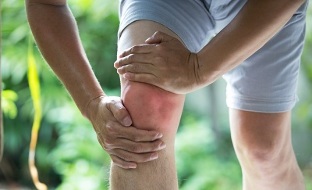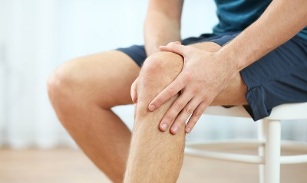
Knee arthrosis or gonarthrosis mainly affects women, usually after the age of forty. At an earlier age, such a pathology can develop as a result of injury or professional sports. A particularly severe course of the disease is observed in people who are overweight or have varicose veins in the lower extremities.
The development of the disease is characterized by the appearance of moderate knee pain while moving, especially when walking on stairs. Pain can also occur when a person is sitting or recovering for a long time. At rest, the pain usually subsides. Sharp and intense pain in knee arthrosis does not occur spontaneously, usually preceded by long-term discomfort when accompanied by physical activity. Gradually increasing pain is a major sign of gonarthrosis.
Stages of the disease
First section
In the initial stages of the development of gonarthrosis, the bones of the knee do not change shape, only swelling of the joint may occur, which is usually accompanied by fluid accumulation in the knee. If the amount exceeds the allowable level, edema develops that affects the back of the foot. In this case, you can use anti-inflammatory drugs to relieve the swelling.
Second Section
The next stage of knee arthrosis is characterized by a significant increase in pain intensity. The pain is felt even after a slight load, the crack in the knee joint appears, which increases as the disease progresses. The patient has difficulty bending his leg, severe pain occurs, until the complete impossibility of bending to the knee. Also in the second stage of the disease, the joint changes its shape, which becomes quite noticeable when touched - the expansion and fusion of the joint bones can be felt. Synovitis is much more pronounced at this stage - the appearance of swelling due to fluid accumulation.
Third Section
The third stage of the disease is characterized by the appearance of intense pain, which also occurs at rest. The patient seeks a suitable situation for a long time in which the pain becomes weaker. In case of impaired blood circulation, the pain can disturb the person even during sleep and cause a painful feeling in the joint. Joint mobility is minimized, people are often unable to keep their legs upright and are forced to bend while walking. With significant deformation of the bones, the gait becomes cotton wool, the change in the shape of the lower limbs becomes noticeable.
How to recognize knee arthrosis?

The patient is first referred for a blood test, followed by an X-ray, magnetic resonance imaging, or computed tomography.
In some cases, ultrasound or arthroscopy (examination of the joint with a special device through a small incision) may be required.
An X-ray examines the stage of the disease, showing changes in the joint and bones, and the distance between the bones. In the early stages of the disease, changes in cartilage tissue are not seen on X-ray.
Ultrasound and computed tomography allow the detection of abnormalities in soft joint tissue and the amount of fluid accumulated during the development of synovitis.
How is knee arthrosis treated?
Knee arthrosis is treated by specialists such as a rheumatologist or an orthopedist. At an early stage, the disease can be cured in most cases without surgery, but treatment must necessarily be comprehensive and qualified. In the second and third stages, it is impossible to restore the joint to its former shape without surgery, it can only be improved on the condition of the periarticular tissues.
Nonsteroidal anti-inflammatory drugs are widely used to reduce inflammation and pain in knee arthrosis. After reducing the pain syndrome, the patient can prescribe massage, therapeutic exercises, physiotherapy procedures.
Drugs that belong to the group of chondroprotectors and ensure the restoration of cartilage tissue are also used to treat gonarthrosis. Such formulations help maintain cartilage elasticity, the saturation of tissue with moisture. In the first and second stages, the chondroprotectors act gradually, the treatment is quite long and can take up to one or one and a half years. Concomitant use of glucosamine and chondroitin sulfate has a greater effect. In the third stage, such drugs are no longer able to have a positive effect.
Drugs that dilate blood vessels have a good effect in the treatment of arthrosis. They can improve blood circulation in the joint and relieve cramps in the small blood vessels, which helps to restore the affected joint. It is recommended to combine the use of such drugs with the use of chondroprotectors. Muscle relaxants may be prescribed to the patient to relieve painful muscle cramps. Such drugs are used only in combination with chondroprotectors and joint traction. Dimexide compresses also have a positive effect in the treatment of arthrosis, which reduces inflammation and relieves pain, especially when fluid builds up. To make such a compact, mix a tablespoon of boiled water with a tablespoon of Dimexide. Then moisten the medical bandage in the resulting solution, then place the affected joint on it and cover it with a plastic bag and diaper on top. The duration of the procedure is twenty to sixty minutes, once a day, for no more than two to three weeks.
All medications are used in the absence of contraindications, strictly according to the doctor's prescription. Arthrosis of the knee joint requires medication and physiotherapy as well as therapeutic practices.

























